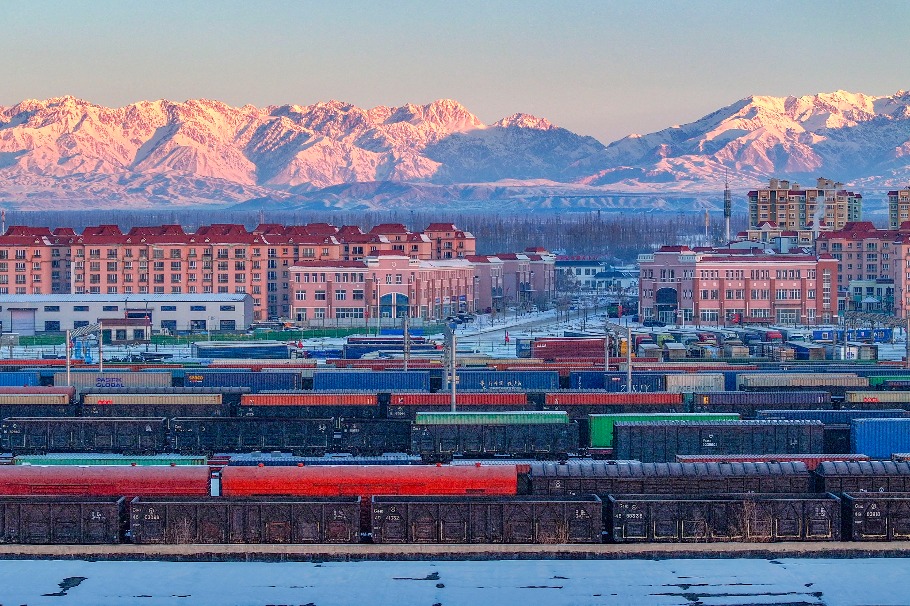Financing integration
The AIIB offers ASEAN the resources to bridge the infrastructure gap and the chance to stay at the forefront of regional geopolitics


Editor's note: The world has undergone many changes and shocks in recent years. Enhanced dialogue between scholars from China and overseas is needed to build mutual understanding on many problems the world faces. For this purpose, the China Watch Institute of China Daily and the National Institute for Global Strategy, Chinese Academy of Social Sciences, jointly present this special column: The Global Strategic Dialogue, in which experts from China and abroad will offer insightful views, analysis and fresh perspectives on long-term strategic issues of global importance.
Multilateral development banks established by the BRICS countries and other Global South countries aim to provide more flexible, efficient and less conditional financing for infrastructure and development projects. They seek to avoid the prolonged bureaucratic delays and stringent policy conditions typically associated with institutions such as the World Bank and the International Monetary Fund, which often promote the Washington Consensus — a set of economic policy prescriptions emphasizing so-called neo-liberalism, privatization and fiscal austerity.
Since 1997, Asian leaders and policymakers have placed more emphasis on regional financial integration and cooperation. Several important initiatives have been launched, notably the Chiang Mai Initiative, the Asian Bond Markets Initiative and the Asian bond funds. Despite these worthwhile initiatives, the region remains much less integrated financially than it is in trade and investment. Most Asian financial markets are more closely integrated with international ones, particularly those in the United States and Europe, than they are with neighboring ones.
Proposed by President Xi Jinping in 2013, and founded in 2015 in Beijing, the Asian Infrastructure Investment Bank represents China's commitment to collaborating with existing multilateral financial institutions while promoting infrastructure development to enhance economic growth in Asia. By offering an alternative source of capital and a different development philosophy, the AIIB and similar institutions represent a push for greater autonomy and influence by emerging economies in shaping their development paths, challenging the traditional economic hegemony of the Global North. This initiative represents a significant step in China's efforts to integrate international economic frameworks and support regional connectivity and development.
This development also reflects broader geopolitical shifts toward a more multipolar global financial architecture. The AIIB has also attracted members from the Middle East, Europe and beyond, demonstrating its global appeal in contrast to regional banks that are restricted to Asia.
With its broad membership, the AIIB has the collective resolve and capability to foster regional cooperation, with a focus on sustainable, technology-driven infrastructure that aims to accelerate Asia's development and integration into a more connected global economy. Asia's economic rise is supported by infrastructure investment, where the China-led AIIB plays a key role by financing projects in sustainable infrastructure, connectivity and green technology, addressing large investment gaps left by existing development banks.
For example, the AIIB assists in transferring capital from economies with excess supply, such as China and Singapore, to those with large demand, such as Cambodia and Myanmar. The AIIB encourages Asian investors to invest locally rather than depending on outside funding by expanding the region's capital markets.
This year marks the 10th anniversary of the establishment of the AIIB. As a mature, high-caliber multilateral financial institution co-governed by emerging nations, the AIIB has become a new force in the global financial order after the 2008 financial crisis and has proved there is a viable path to a fairer, more equitable and effective global financial and development governance.
The principle of championing the norms established by multilateral development banks is coherently followed by the AIIB. Efficiency, quality and less red tape are given top priority in its institutional framework. Although the AIIB prioritizes important project quality criteria, its project procurement and risk analysis processes are more effective than those of other multilateral development banks. This makes it possible for the AIIB to operate more efficiently while guarding against risks.
The AIIB offers the Association of Southeast Asian Nations countries the chance to stay at the forefront of regional geopolitics and the resources to bridge the infrastructure gap. Institutions such as the AIIB will be crucial in ensuring that growth is stable, sustainable and inclusive as Asia's economy continues to expand. The true test will be whether the AIIB can strike a balance between accountability and speed and efficiency.
The burgeoning field of digital governance and cooperation has also become a new area of growth in AIIB financial activities. The rise of e-commerce and digitalization, with settlement of local currencies and cross-border logistics, holds significant potential to address challenges in integrating financial and real economic activities within ASEAN. Although still developing, these technologies can greatly enhance ASEAN's economic integration by boosting cross-border trade and enabling companies to participate more effectively in global production networks. As the digital ecosystem evolves and regulatory frameworks improve, e-commerce and financial integration are expected to drive greater business efficiency and economic growth across the region.
In the future, AIIB-supported projects can be more successful and efficient if local risks and opportunities are better understood. Regional adoption of global financial standards, along with the AIIB's role, can enhance transparency, competition and reform in domestic markets. While embracing ASEAN's central role in regional economic integration, China and ASEAN can use the AIIB as a mechanism to extend and consolidate the regional framework of cooperation and governance.
The AIIB is a strategic symbol of the Global South's collective action as well as a regional financial instrument. By more swiftness and adaptability in meeting Asia's extensive infrastructure needs, it fills the gaps left by Western sluggish decision-making and conditional loans, and it provides a new financing channel for the Asian region.
The author is an economics professor at Malaysia's HELP University. The author contributed this article to China Watch, a think tank powered by China Daily.
The views do not necessarily reflect those of China Daily.
Contact the editor at editor@chinawatch.cn.


































